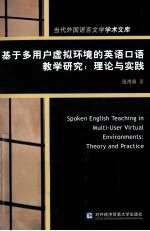

基于多用户虚拟环境的英语口语教学研究 理论与实践PDF电子书下载
- 电子书积分:12 积分如何计算积分?
- 作 者:张海森著
- 出 版 社:北京:对外经济贸易大学出版社
- 出版年份:2010
- ISBN:9787811348378
- 页数:301 页
Chapter 1 INTRODUCTION 1
1.1 Background of the study 2
1.2 Statement of the problem 8
1.3 Purpose of the study 12
1.4 Significance of the study 14
Chapter 2 LITERATURE REVIEW 17
2.1 Spoken language learning 17
2.2 Major factors that affect spoken language learning 19
2.3 Effectiveness of spoken language learning 25
2.4 Learning behavior and its effect on academic achievement 30
2.5 Language learning in MUVEs 33
2.6 Current developments in language learning with technology 38
Chapter 3 THEORETICAL FRAMEWORK 47
3.1 Second language acquisition 47
3.2 Language learning in MUVEs 51
3.3 Educational affordances of MUVEs 58
Chapter 4 METHODOLGY 67
4.1 Design 67
4.2 Instrumentation 79
4.3 Data collection 87
Chapter 5 RESEARCH FINDINGS 91
5.1 The current state of spoken English learning in the physical world 91
5.2 Learning characteristics of the less proficient students 99
5.3 Learning characteristics of the more proficient students 116
5.4 Characteristics of spoken English learning in MUVEs 132
Chapter 6 DISCUSSION 159
6.1 Spoken English learning in traditional learning contexts 159
6.2 Pedagogical affordances of MUVEs for spoken English learning 175
6.3 Behavioral characteristics of spoken English learners in MUVEs 182
6.4 The conceptual framework of spoken English learning in MUVEs 185
6.5 A pedagogical model of spoken English learning in MUVEs 189
6.6 Pedagogical challenges of spoken English learning in MUVEs 214
Chapter 7 CONCLUSIONS 225
7.1 Summary of major findings 226
7.2 Pedagogical implications 228
7.3 Limitations of this study 233
7.4 Suggestions for further research 233
Appendix A A Questionnaire on Routine Spoken English Learning 235
Appendix B An Interview Protocol for Identifying Routine Spoken English Learning Behaviors 243
Appendix C An Interview Protocol for Identifying Spoken English Learning Behaviors in Second Life 245
Appendix D Observation Protocol 249
Appendix E Some Sample Oral Tasks 251
References 262
Acknowledgments 299
Figure 1 Units of spoken language,originated from Bailey (2005) 18
Figure 2 Percentage of the learners for improving the four language skills 92
Figure 3 Attitude toward class time for spoken English learning 94
Figure 4 Motivation for improving spoken English 94
Figure 5 The optimal number of group members 95
Figure 6 The most favorite topics for discussion activities 96
Figure 7 The perceived most effective learning method 97
Figure 8 Frequency of practicing spoken English on a daily basis 98
Figure 9 Available opportunities for practicing English with native speakers 98
Figure 10 The top five factors that affect spoken English learning 99
Figure 11 A model of the less proficient students'spoken English learning 115
Figure 12 A snapshot of a learning site in the Kwansei sim 132
Figure 13 A snapshot of Voice-aholics Headquarters 136
Figure 14 A snapshot of a discussion activity at the IBM conference center 151
Figure 15 A snapshot of the immersive learning context at the Great Wall 153
Figure 16 A conceptual framework of effective spoken English learning in traditional learning environments 161
Figure 17 A model of effective spoken English learning 170
Figure 18 The conceptual framework of spoken English learning in MUVEs 186
Figure 19 A pedagogical model of scaffolded blended spoken English learning 192
Figure 20 A snapshot of the Second Life interface 199
- 《红色旅游的社会效应研究》吴春焕著 2019
- 《高级英语阅读与听说教程》刘秀梅编著 2019
- 《汉语词汇知识与习得研究》邢红兵主编 2019
- 《思维导图 超好用英语单词书》(中国)王若琳 2019
- 《生物质甘油共气化制氢基础研究》赵丽霞 2019
- 《东北民歌文化研究及艺术探析》(中国)杨清波 2019
- 《联吡啶基钌光敏染料的结构与性能的理论研究》李明霞 2019
- 《激光加工实训技能指导理实一体化教程 下》王秀军,徐永红主编;刘波,刘克生副主编 2017
- 《异质性条件下技术创新最优市场结构研究 以中国高技术产业为例》千慧雄 2019
- 《培智学校义务教育实验教科书教师教学用书 生活适应 二年级 上》人民教育出版社,课程教材研究所,特殊教育课程教材研究中心编著 2019
- 《中风偏瘫 脑萎缩 痴呆 最新治疗原则与方法》孙作东著 2004
- 《水面舰艇编队作战运筹分析》谭安胜著 2009
- 《王蒙文集 新版 35 评点《红楼梦》 上》王蒙著 2020
- 《TED说话的力量 世界优秀演讲者的口才秘诀》(坦桑)阿卡什·P.卡里亚著 2019
- 《燕堂夜话》蒋忠和著 2019
- 《经久》静水边著 2019
- 《魔法销售台词》(美)埃尔默·惠勒著 2019
- 《微表情密码》(波)卡西亚·韦佐夫斯基,(波)帕特里克·韦佐夫斯基著 2019
- 《看书琐记与作文秘诀》鲁迅著 2019
- 《酒国》莫言著 2019
- 《大学计算机实验指导及习题解答》曹成志,宋长龙 2019
- 《指向核心素养 北京十一学校名师教学设计 英语 七年级 上 配人教版》周志英总主编 2019
- 《信息系统安全技术管理策略 信息安全经济学视角》赵柳榕著 2020
- 《大学生心理健康与人生发展》王琳责任编辑;(中国)肖宇 2019
- 《大学英语四级考试全真试题 标准模拟 四级》汪开虎主编 2012
- 《大学英语教学的跨文化交际视角研究与创新发展》许丽云,刘枫,尚利明著 2020
- 《北京生态环境保护》《北京环境保护丛书》编委会编著 2018
- 《复旦大学新闻学院教授学术丛书 新闻实务随想录》刘海贵 2019
- 《大学英语综合教程 1》王佃春,骆敏主编 2015
- 《全球贸易摩擦与大国兴衰》任泽平,罗志恒著 2019
